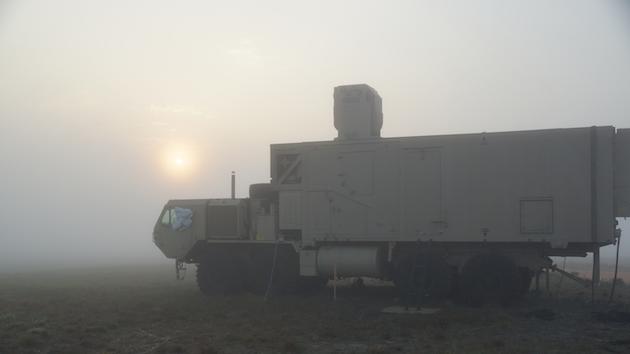wargadget
Latest

Boeing's drone-killing laser takes down targets with an Xbox controller
Boeing has a pretty storied history with lasers and now its testing one that can take out UAVs and rockets regardless of where it's installed. A recent trial run of the tech was conducted in Florida under some pretty grueling conditions (heavy fog, rain and wind), to prove that even a lower-powered version of High Energy Laser Mobile Demonstrator -- HEL MD for short -- is capable in a maritime environment. As Boeing tells it, the firm exceeded all of its goals and successfully engaged with some 150 different targets including drones and 60mm mortar shells with its 10 kilowatt laser. Wired says that the energy beam is powered by lithium ion batteries, and that the whole setup only requires a diesel-backed generator to keep the wheels of war defense moving. Meaning, running out of fuel, not munitions, is basically the only threat the energy weapon faces.

Watch a remote-controlled fighter jet evade a missile
Existing drone aircraft are useful for many things, but they make for lousy target practice when you're testing missiles; they're rarely as maneuverable as modern fighter jets. Boeing and one of its customers have just shown that there's a better way, however, by firing a surface-to-air missile at a remote-controlled QF-16. As you'll see in the video below, the unmanned aircraft is much nimbler than either a purpose-built vehicle or an aging conversion like the QF-4, and gives weapons a real workout. It even managed to dodge the projectile, although you can't really say that the shooters missed. The missile was tuned to avoid hitting its target -- sensors on both the missile and QF-16 confirmed that the weapon was on track without having to blow up expensive equipment. It'll be a while longer before the airplane is regularly serving as an aerial punching bag, but this test proves that it's up to the job.

Octopus-like camouflage can hide you in plain sight
Octopuses and other cephalopods are masters of disguise -- their prey often doesn't realize the danger until it's too late. It only makes sense to model active camouflage after that behavior, then, and a team at the University of Illinois has managed just that. Their octopus-like material uses layers of photosensors, actuators and temperature-sensitive pigment to detect ambient light and change colors in response. Individual points on the unversity's test skin can turn from black to transparent within a second or two, letting it quickly blend into its surroundings -- or purposefully stand out, as you see above. The technology will ideally allow for many colors in the future, although that's not an immediate priority.

New fighter pilot helmet delivers night vision without goggles
Fighter pilots have access to helmets with amazing abilities. However, they still have to strap on heavy night vision goggles to fly in the dark -- an all too literal pain in the neck. Much to aircrews' relief, BAE Systems wants to make that clunky headgear a distant memory. Its brand new Striker II helmet includes a night vision camera that projects its footage on to the visor's high-resolution display, giving the pilot a good look at the outside world without the need for extra equipment. The tech should be far more comfortable during lengthy missions, especially in sharp turns where G-forces make any added weight feel that much worse.

Watch an AlphaDog robot venture into (simulated) battle for the first time
They grow up so fast, don't they? It seems like only yesterday that Boston Dynamics' AlphaDog (aka LS3) robot was finding its legs, and yet it has already gone out on training exercises with the US Marine Corps for the first time. The cargo-hauling machine dutifully trotted behind a Marine squad traversing a simulated combat zone in Hawaii, proving that it could both navigate rough terrain and resupply other platoons that would otherwise have to wait for an ATV.

Watch these smart bullets home in on targets like tiny missiles
Soldiers have long dreamed of smart bullets that always hit their targets, and it looks like they're now much closer to getting their wish. DARPA has posted the first footage of EXACTO (Extreme Accuracy Tasked Ordnance), a .50-caliber bullet that uses optical guidance and sensors to home in on its prey. As you see in the fuzzy-looking video below, the projectile compensates for movement, weather and wind with all the agility of a missile -- even if you try to miss, it easily swerves back on track. The project is still young, but it could prove a tremendous help to long-distance snipers for whom even the tiniest slip-up could ruin a shot.

The US is getting Hollywood's help building a real 'Iron Man' battle suit
The US hasn't had much success building mechanized battle suits that move quickly and stop bullets, but Hollywood has been dreaming up these concepts for years. Don't they already know a thing or two about designing high-tech armor? Apparently, the US military thinks so -- it's enlisting the help of Legacy Effects, which has built suits for Iron Man and RoboCop, to shape its TALOS (Tactical Assault Light Operator Suit) project. The company is both designing and 3D printing prototype pieces that will give a feel for what the armor is like in the real world.

Watch a sniper nail his target from 500 yards without even 'looking' at it
Smart-weapon company TrackingPoint seems pretty intent to make real-world guns act like the virtual firearms we use for offing video game villains. The latest demo of its ShotView targeting system showcases live video being transmitted from a rifle's scope to a set of off-the-shelf Smith Optics I/O Recon goggles via WiFi, enabling the marksman to hit an explosives-filled pop bottle from 500 yards down-range without even looking at it. While the previous concept clip used Google Glass, a TrackingPoint spokesperson tells us that the Smith goggles don't lag like Google's wearable does in this scenario. Speed might not make a huge difference at the firing range, but, for soldiers in the field, we'd imagine that keeping pace with a mobile target is somewhat important -- especially if they aren't physically looking at it. For a gander at an advanced warfighter's possible arsenal, make sure to peep the video below.

The US military wants walls that automatically pop out of cans
Many soldiers dream of having instant cover on the battlefield, and it looks like they might just get their wish. DARPA is soliciting proposals for BlockADE (Block Access to Deny Entry), a system that would automatically form a barrier from material stuffed into a canister 1ft by 6.5ft or smaller. If US troops needed to block off an entrance or create a makeshift building, all they'd have to do is hit a button -- much more effective than sandbagging or pitching a tent, we'd say.

The US Air Force's oldest bomber is now a flying network
The B-52 may be one of the US Air Force's most reliable bombers, but it's not exactly a technology powerhouse; some of its systems were only fresh when Kennedy was President. The aircraft's newly-delivered CONECT (Combat Network Communications Technology) variant is finally catching up with the times, though. It's effectively a network hub with wings. A wideband satellite link keeps the machine in touch with other Department of Defense systems, letting it receive new mission plans and redirect smart weapons after they've launched.

UN debates a preemptive ban on killer robots
Killer robots are at the heart of popcorn fare like the Matrix and Terminator movies, but there's a serious debate underlying it all: do we want to trust fully autonomous machines with lethal weapons? Some would argue that it's just too risky, and the United Nations has accordingly held its first meetings discussing a potential ban on the concept before it ever gets off the ground. Critics (including the UN's acting European head, Michael Moeller) argue that deadly robots may not consistently obey humanitarian laws, particularly in tricky situations; they may do things that are logically sound, but morally flawed. There are also worries about accountability, since it may be difficult to hold armies and police forces directly responsible for deaths at their robots' hands.

Watch Lockheed Martin's laser weapon take down boats from a mile away
It's good that Lockheed Martin's ADAM laser can shoot down drones and rockets, but there are threats much closer to Earth -- say, small boat crews bent on destroying large warships. Never fear, though, as we now know that ADAM can take care of those targets as well. Lockheed has successfully wielded the weapon against small boats, burning holes through their rubber hulls from a full mile away. The laser's automatic infrared tracking makes targeting a piece of cake. Even with the pitching of the waves, it's easy to aim at a specific point on a vessel.

Norway's VR test helps soldiers see through armored vehicles
There's a good reason why games like Battlefield rarely offer a realistic view of what it's like to steer armored vehicles: actual drivers have to either look through tiny portholes or risk getting shot. The Norwegian Army may not be so restricted in the future, though. It's testing a system from MakingView that uses Oculus Rift VR helmets to help soldiers glimpse through a vehicle's protective plating. The headset is linked to a set of cameras that, like a recent drone experiment, lets drivers simply look in a given direction to see what's outside.

DARPA envisions a smarter, safer autopilot
Autonomous aircraft serve their purpose, but there's no question that pilotless passenger flights are a long way off, if they ever become a reality. Still, there's obviously room for improvement when it comes to on-board systems that assist pilots in their duties. The Defense Advanced Research Projects Agency (DARPA) is in the process of creating an advanced autopilot system called ALIAS (yes, another acronym). The Aircrew Labor In-Cockpit Automation System (there you go) would control military aircraft in all stages of flight, from takeoff to landing -- even during a system failure. Pilots would interact with the system using a touchscreen and voice control, supervising a flight instead of commanding it. Of course, we'll see this technology make its way to military planes long before it's adopted by airlines, but ALIAS could play a key role in keeping us all safe at 30,000 feet.

Elite soldiers will soon ride into battle on stealthy hybrid motorcycles
The US' special operations forces frequently can't rely on conventional ground transportation for their covert ops -- a loud engine is guaranteed to blow their cover. To tackle this problem, DARPA has just awarded Logos Technologies a contract to build a stealthy hybrid motorcycle for the military. The design modifies BRD's all-electric RedShift MX (pictured here) with a quiet hybrid power system that can run on multiple fuel types. The overhaul lets soldiers travel long distances while keeping a relatively low profile, and they can run solely on electric power for shorter periods if silence is absolutely vital. It's too soon to say when the bike will go into service or just how well it will perform, but it could be a lifesaver for troops that need both speed and secrecy.

US Navy fine tunes seafaring laser weapon and unmanned robocopters (video)
That electromagnetic railgun is cool and all, but it's not the Navy's only wargadget in progress. Apparently, the Armed Forces branch has also been working tirelessly to improve its ship-mounted lasers and autonomous helicopters since we'd last heard about them. The new laser prototype, in particular, is a beefed-up version of what we saw in 2013. It's capable of firing high-energy beams for $1 per shot, providing ships a low-cost alternative to weapons that require expensive ammunition. Within the past months, Navy engineers have consolidated the weapon's controls, so a single person can target, track and fire at threats like unmanned aircraft and attack boats using only a video game-like controller. The Navy wants to deploy this cost-effective death ray this summer aboard the same ship its predecessor occupied (the USS Ponce in the Gulf Sea), but it's still going through some final-stage adjustments.

SkyShield protects airliners from missile strikes, completes testing in Israel
SkyShield, created by Israel's Elbit Systems, has reportedly been under development for the better part of a decade, but the laser-based missile deflector has just now successfully completed live testing. The Multi-Spectral Infrared Countermeasure (MUSIC) device, which is mounted on an aircraft's belly, uses a thermal camera paired with a laser to change the direction of approaching missiles, saving airliners and passengers from destruction. When the camera detects a missile, it rotates the plane so that the belly faces the approaching weapon. It then fires a laser beam, redirecting the missile so it can explode a safe distance away. It's not clear when the technology will begin rolling out, but according to Haaretz, SkyShield will be used on all Israeli civilian aircraft, many of which operate around the world.

DARPA taps IBM to help create self-destructing gizmos for the battlefield
When you look at DARPA's newest project, it almost feels like the agency's recent breakthroughs have left it a little drained, creatively. The government's research wing has announced that IBM is helping it create non-incendiary self-destructing devices for use in the field. Yawn. The new VAPR (Vanishing Programmable Resources) program would use a CMOS sensor attached to a piece of glass that, when triggered by an RF-signal, would shatter on command and destroy the sensor in the process. As the outfit tells it, this would ensure that these "transient electronics" -- such as sensors for monitoring an area for a specific time-period -- don't fall into the wrong hands and give away classified information. These sound pretty handy to be sure, but they aren't nearly as cool as robo-beetles. [Image credit: Kenno_mcdonnell/Flickr]

Garmin Tactix ruggedized GPS watch lets you play Navy SEAL for $450
Garmin's gone after swimmers, runners, pilots and golfers with its specialty watch lineup, and now battlefield-trained agents are getting some attention from the global GPS giant as well. The company's latest wrist-mounted machine is dubbed Tactix, and as you may have guessed from the design, it was "inspired by the requirements of law enforcement and police special operations." There's an altimeter, barometer and a 3-axis compass. US devices come preloaded with tide data (for amphibious wearers) and all watches include Jumpmaster software (for airborne use). It's waterproof to 50 meters, has a night-vision-friendly green backlight and can track GPS coordinates for up to 50 hours on a single charge. It also functions as a boring ole wristwatch, with timer, stopwatch, world clock and alarm functionality. The Garmin Tactix, which ships in matte black, is expected in stores later this year for $450.

Visualized: F-35B fighter's vertical landing, in the dark (video)
The jury's still out on Lockheed Martin's F-35B fighter. The aircraft is expected to cost the US more than $1.5 trillion over its lifetime, and it's been described as being too heavy and too sluggish -- one critic has gone so far as to call the jet a "dog." One thing's for sure, though: the F-35 looks mighty impressive, especially when it's landing vertically on an aircraft carrier. In the dark. Click past the break for a look at Lockheed's trillion-dollar light show, courtesy of Uncle Sam.



